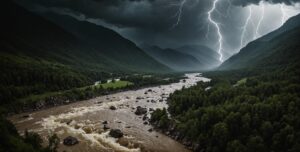
Resiliency, Climate Change, and CA Community Colleges
Those who don’t learn from the past are doomed to repeat it, so the adage says. The State of California has made it policy to learn from its past experiences. It is intentionally building resources and systems that reduce or eliminate the risks that have caused damage to it and its residents in years past.
Climate change is the biggest instigator of these ‘repair and recover’ efforts. In the past five years, the State has experienced no less than 70 environmental catastrophes, all of which were driven by the planet’s changing climate and weather patterns. In response, Governor Newsom launched his ‘Request for Innovative Ideas‘ initiative and its companion ‘Innovation Procurement Sprint‘ process early in his first term. These two efforts combine to attract and engage the State’s best innovators and entrepreneurs to collaborate on solutions to climate change-induced threats and challenges.
Further, in addition to private sector contributors, the Governor has also enlisted the resources and support of California’s 116 Community Colleges (CCC) to contribute their particular capacities to the endeavor. The colleges present a series of unique and sometimes conflicting realities:
- They contribute to the environmental challenges caused by climate change. The campuses occupy thousands of acres of public lands and operate in hundreds of buildings, all of which were designed and built using ‘legacy’ systems. Their physical footprints often generate the same types of pollutants and toxins as other built regions, from standard garbage and waste to excess exhaust of petroleum-based fuels such as natural gas.
- At the same time, they also have the resources needed to combat the climate change concern. Collectively, the schools register over two million students each year, and, in many cases, they are an employment and cultural anchor in their local community. The schools provide instruction, guidance, and direction to those millions of learners, and can offer training and courses in almost any discipline that has a comparable workforce demand.
Because of these unique realities, and combined with their locations in all corners of California, the CCCs also offer a unique opportunity to design and implement climate-forward policies that can and will impact the entire state.
The good news is that the California Community College Chancellors’ Office (CCCCO) recently announced its intent to achieve exactly that. In July 2025, the CCCCO presented its ‘CCC Climate Action Framework‘ as the foundation for its effort to both reduce the impact of climate change on California while also building a ‘blue and green’ workforce to drive that future economy. By doing so, the agency has declared its place as a leader in combating climate change, and its intent to use its resources to reduce that impact while improving the lives and economies of all Californians.
The Framework fits neatly into the CCC’s Vision 2030, a 2023 ‘Roadmap for California Community Colleges’ presented by the CCC’s Board of Governors. Updated in July 2025, Vision 2030 embeds equity into every CCC project while also advancing its whole-system approach to enhancing California’s unique economic opportunities.
The CCC Climate Action Framework (CCC CAF)
The CCC CAF initiative seeks to accomplish several goals:
- To transform the CCC corps into a unified network of expertise and resources working toward resiliency, sustainability, and climate justice for all state residents.
- To develop climate-focused standards and practices that will facilitate a cleaner environment in all regions in the State, regardless of the type of climate challenge they may face.
- To build a workforce capable of managing existing and emerging climate-control assets and systems, thereby ensuring not just a healthier community but also a healthier economy for all.
The CCC CAF strategy draws on all of the CCCs’ assets, bringing together experts in education, science, policy, and industry to craft a one-of-a-kind yet fluid model for resisting and managing the damages caused by weather and climate-related disasters. Its four populations reflect its focus on advancing each school’s resources to address the full parameters of climate action and mitigation drivers:
Climate Fellows: These education professionals are CCC leaders from all 116 schools. They will focus on four pillars of activity within each region to knit together optimal teams for climate action. The teams will address:
- student and community engagement;
- campus facilities and operations;
- workforce development for green (land) and blue (water) economies, and
- climate literacy development throughout course curricula.
Climate Corps Fellows: These four individuals are already at work, conducting a comprehensive analysis of the CCC’s combined sustainability efforts. Their focus is to identify and understand how each school manages its energy, water supply, waste, and procurement practices to develop a system-wide image of CCC environmental activities. Once complete, the analysis will inform future alignment across the school corps with statewide climate goals.
Student Climate Fellows: This group will consist of students from all 116 schools, those who are passionate about climate change as a unique challenge and who will work to achieve positive changes on their individual campuses through one of three focus areas: campus facilities, campus outreach, or student activities and clubs. As a unified entity, they will share resources and insights to develop scalable projects that advance not just their climate-focused effort but also the larger goals of Vision 2030.
Climate Ambassadors: Comprised of both academics and industry experts, these professionals will be informing the CCCCO about promising strategies and practices as those develop around the state. As a think-tank, the group will offer recommendations as to how the CCCs can add resources to California’s ongoing climate awareness and sustainability efforts. As an advisory entity, the Ambassadors will be influential on CCC climate efforts across all disciplines of the overarching CCC CAF.
The CCCCO considers the CCC CAF to be a ‘distributed leadership model’ that spreads the focus, effort, and investment in climate-facing issues across the entire state through its network of community colleges and their local and regional partners. By embedding the personnel and workload within each school, the CCCCO is ensuring not only that California’s colleges are well prepared to address the challenges wrought by climate concerns but also that the State develops the workforce needed to effectively approach and manage climate and weather-related issues as they arise.
California’s weather realities over the past five years have clearly demonstrated that the state, as a whole, needs to shift how it addresses climate change. In conjunction with the Governor’s office, the state’s network of community colleges is now leading the effort to reduce or eliminate climate-induced threats to its environment and populations. Considering the depth and scope of its calculated CCC CAF strategy, the CCCCO is demonstrating that it has learned from the past and will not be unprepared for an uncertain climate future.


